
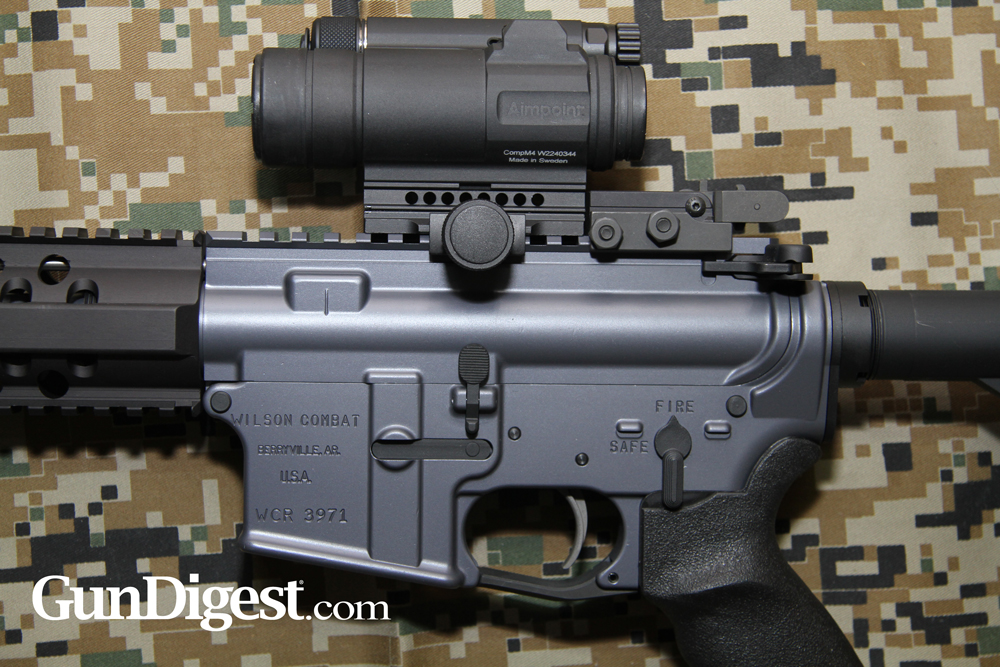
Everyone knows a Wilson Combat 1911 is top of the line. In this AR-15 review, Patrick Sweeney argues the same can be said for the Wilson Combat 6.8.
If you spend any time at all in a competitive endeavor, you’ll quickly realize that skill at any given contest does not necessarily carry over to another. The list of professional ballplayers (football, baseball, whatever) who were good on the field, and then good as a coach, is small. The list of professional sports figures who go on to open successful businesses is small, indeed.
Skill in any endeavor is a rare thing. We should expect, therefore, that skill in two would be rarer still. Which is one of the things that makes Bill Wilson rare. Were I given to the usual sloppy hyperbole that modern writing schools seem to encourage so much, I’d call him unique. He isn’t. As good as he is, he isn’t the only one to be successful as a businessman in the field in which he saw such fame as a competitor. And make no mistake, he was a heavyweight back in the early days of IPSC, and he’s a heavyweight now in the field of custom guns.
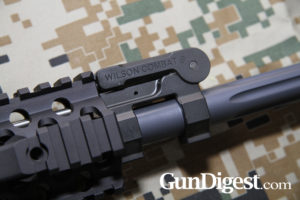
Starting with 1911s, Bill has expanded to the modern triumvirate of defensive artillery: the 1911, the 870, and the AR. Wilson ARs are built on 7075-T6 forgings, precision machined (and in this day and age that means CNC multi-axis machines) and hard-coat anodized. The receivers are then given a Wilson Armor-Tuff baked-on epoxy finish, in your choice of green, black, tan, gray or stainless, depending on the model. They all have Wilson match-grade barrels, 16, 18 or 20 inches, depending on what model you choose. The smallbores have 5.56 chambers for reliable chambering and to avoid the problems that .223 chambers can bring when fed a diet of 5.56-spec ammo.
As with his 1911s, you can get a standard, Wilson-spec rifle: just pick the catalog number, phone or email your order, and your FFL will be receiving it in short order. Or you can custom-build the AR of your heart’s desire by starting with a Wilson model and substituting items such as flash hiders (Vortex, A2 or Wilson Tactical Muzzle brake?), stocks (Magpul or M4?), folding sights (Wilson makes a handful, front and rear), and your choice of railed handguard – and do you want low-profile rail ladders, or full-profile rail covers?
Scope mounts, optics, pistol grips, charging handles, bolt releases, foregrips, all can be spec’d and either left as-is or Armor-Tuff® coated to match.
But you knew all that, right? I mean, you’re an AR fan who stays in the know, so none of that is news to you. Well, guess again; Wilson is now making rifles in 6.8.
Developed to provide a significant increase in terminal effectiveness without making recoil onerous, the 6.8 Remington SPC is a big step up. If you want a rifle chambered in a cartridge a lot more suited to hunting (and it will pass muster even in States where the DNR does not allow .223/5.56 for deer hunting) while being the modern, reliable, and accurate rifle of the 21st century, the 6.8 is a good choice. The Wilson 6.8 project simply takes the already-excellent Wilson AR and replaces the 5.56 parts with 6.8.
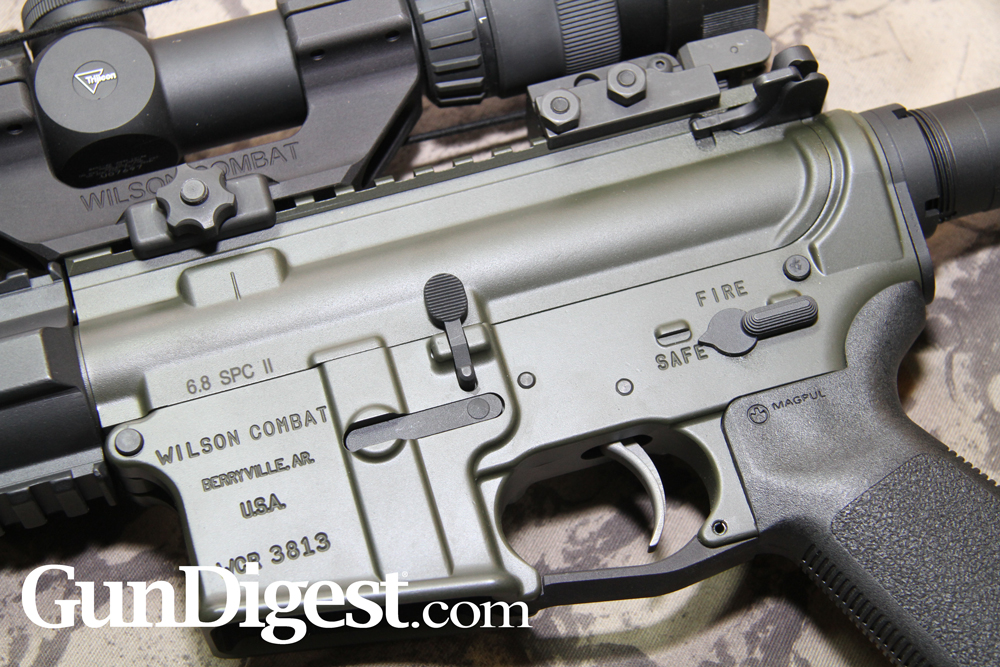
The barrel is a stainless medium weight match grade barrel with a 1:11 twist and an SPC II chamber. That means you have the pressure-lowering benefits of the new throat and leade and the accuracy of a match barrel but the relatively slow twist to increase bullet instability on impact. The gas system is mid-length, for a lower port pressure and less abrupt gas flow, while still maintaining a length-enough gas dwell time for reliable function. You have a choice of 16- or 18-inch barrels, and the railed forearm is appropriately proportioned for each. The match barrel is guaranteed to deliver MOA accuracy with match-grade ammo.
The new Wilson Combat Quadrail is interesting. It is fully-railed on top, but on the side the rails are carved off just forward of the midpoint. That gives you a slimmer, more oval shape, and one that doesn’t have rails to gnaw at your hands. But the forward sections of rail provide plenty of space to mount lights, lasers, and other tactical goodies.
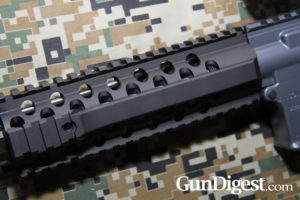
The trigger is the Wilson single stage TTU for a clean and crisp letoff, but one that feels like any other AR trigger, just a lot nicer. If you opt for a complete rifle, you get Magpul stock and pistol grip. If , however, you already have an AR (let us hope it is a Wilson, so the upper won’t feel lonely) then you can simply acquire a Wilson 6.8 upper to put on your existing lower.
Now, if you want to shave half a pound off your full-up weight, then the Wilson Tactical Hunter Lightweight 6.8 SPC will do that. With a 16-inch barrel of a slightly slimmer profile, the Tactical Hunter becomes a very light, handy, mid-power hunting rifle, and one with guaranteed MOA accuracy.
But wait, we’re not done yet. Options! You get options.
You can replace the single-stage TTU with the two-stage TTU and get a target/competition trigger pull in your rifle. The single stage is 3.5 pounds, the double is 3, but the difference is greater than that. on a single-stage trigger, you press on the trigger, and when you reach the break point, 3.5 pounds, the trigger moves and the hammer falls. On a two-stage trigger, you take up a pound and a half of slack, and then another pound and a half releases the hammer. If you decide not to shoot, letting go of the trigger relaxes that pound and a half of take-up you started.
You can also opt for a Wilson oversized bolt stop, if you’re using it in competition. You have your choice of a fixed or folding front sight, and two different folding rear sights, as well as an A2 detachable carry handle rear.
Scope rings: you get a choice of one-inch or 30mm, and they fit over the folding Wilson rear sights.
Or you can simply build your Wilson 6.8 as an M4 clone.
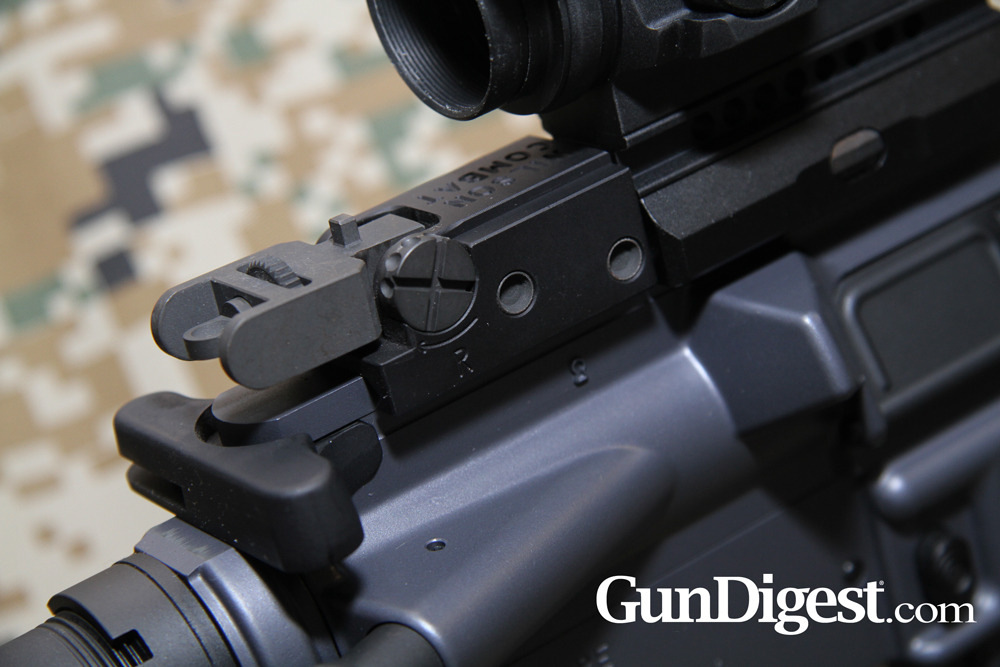
If you want to do the work yourself, Bill is more than happy to accommodate you. You can order up a 6.8 barrel, in one of six length/profile/fluted or unfluted combinations, and a bolt and carrier combo made for Wilson by LMT, complete with NP3 plating. Magazines, ammo, flash hiders, and case gauges for the reloaders are all available from Bill. As I said, he’s a really good businessman.
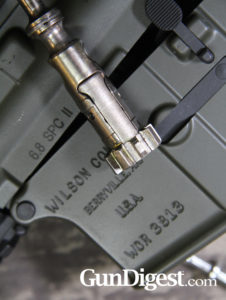
The two things that jumped out at me when I had a chance to handle and shoot the Wilson 6.8 were the handguards and the front sight. The new FUFS is a sleek and clean folded sight that locks in either the up or down position. When it is folded, it is not just unobtrusive, it is almost hidden. And when it is up, it is locked there. The button to unlock it is guarded, so it is highly unlikely that you will accidentally brush the button and partially fold your front sight.
If you are wedded to sights on the rail, Wilson also offers a folding front sight that fits there, too.
The Combat Quadrail has full-length top and bottom rails, but the side rails are sculpted on the rear two-thirds or so. This gives you a firm hold without the “bite” of rails on the sides. It also give you a better index on the front hand, so you know if the rifle is vertical as it comes up, and you don’t have to hunt for the sights once you’ve shouldered it. As a bonus, there are eight threaded holes (1/4″X20) where you can bolt on something that needs more than just a rail or that can be bolted on and take up less space than a quick detach system requires.
Made from 6065 T5 and hard anodized, you’re going to have to work to wear this one out.
How did they shoot? Do you really have to ask that? With a Trijicon 3-9 on one Tactical Custom and an Aimpoint M4 on the other, the results were as expected: lots of easy fast, close-range hosing on drills, and nice, even, small clusters on the 100-yard targets. The Wilson triggers made shooting a breeze, and the rifles ran flawlessly.
You really do owe it to yourself to shoot a Wilson. You won’t be disappointed.
This article is an excerpt from the The Gun Digest Book of the AR-15 Vol. III.

Next Step: Get your FREE Printable Target Pack
Enhance your shooting precision with our 62 MOA Targets, perfect for rifles and handguns. Crafted in collaboration with Storm Tactical for accuracy and versatility.
Subscribe to the Gun Digest email newsletter and get your downloadable target pack sent straight to your inbox. Stay updated with the latest firearms info in the industry.

![Best Concealed Carry Guns In 2025 [Field Tested] Wilson Combat EDC X9S 1](https://gundigest.com/wp-content/uploads/Wilson-Combat-EDC-X9S-1-324x160.jpg)


![Best 9mm Carbine: Affordable PCCs [Tested] Ruger Carbine Shooting](https://gundigest.com/wp-content/uploads/Ruger-Carbine-Shooting-100x70.jpg)
![Best AR-15: Top Options Available Today [Field Tested] Harrington and Richardson PSA XM177E2 feature](https://gundigest.com/wp-content/uploads/Harrington-and-Richardson-PSA-XM177E2-feature-100x70.jpg)

Wow. I know this comment is old, but seriously? “…one of the most unreliable military rifles of all time.”
You’re promulgating a myth that has no evidence whatsoever. I have not heard of any mass complaints regarding reliability of the AR-15 since early Vietnam. Please show us some evidence to back up your claim that it is “horribly unreliable.” I heard those groundless stories when I was a kid and believed them for years, until I started talking to people who had actually used them in combat. Still haven’t heard of any major malfunctions during combat.
Also, you’re right that the .223 has decent lethality, and I used one for deer hunting for years growing up, but I would hardly call a 6.8 a “big bore.” Also, there is no way to argue that the 6.8 doesn’t have more energy than a .223. It also has a greater effective range” It sounds like you’ve made a lot of big claims based on anecdotal evidence (“shooters I have interviewed” – really?) I’ve heard the accuracy is at least as good as the .223, but wouldn’t base my opinion on what a few individuals think they know.
I’m not going to say that “newer is always better” but for most big game hunters (who usually don’t have carefully placed shots on perfectly still broadside standing game), a larger caliber is a better option as it will somewhat compensate for minor inadequacies in the accuracy department.
Same old advertisement hype: Newer is better, run out and get two right away.
Competitive shooters I have interviewed tell me that the 6.8 and 6.5 clones are actually less accurate than the standard .223.
How about lethality? Since the days of the king of charlatans “Elmer Keith”, who beat the big bore drums for years, the public has been brain washed into believing such hog wash. Real hunters have known for the last century that bullet diameter is quite meaningless. Shot placement and penetration are what counts the most.
Real hunters of yesteryear like Jack O’Connor, Agnes Herbert, W.D.M.Bell and a host of others proved beyond doubt that small bore rifles with long heavy bullets penetrated far better than slower moving less penetrating big bore calibers. Roy Weatherby once stopped a charging African Buffalo with one shot from a .240 Weatherby. W.D.M.Bell who used big bore and small bore guns reported only his 6.5mm was able to consistently shoot right through an Elephants skull. He should now as he shot over 1,000 elephants, far more than Keith’s one or two.
The .223 when used with the long heavy bullets has plenty of penetration and lethality and it does it with less recoil and the ability to carry more ammo. The only the thing the U.S. military should do is scrap the AR-15 system as it is one of the most unreliable military rifles of all time, it stands shoulder to shoulder with the horribly unreliable WWI French Chauchat. I could also mention the Rashid and others like it that used the same unreliable gas impingment system the AR-15 uses.